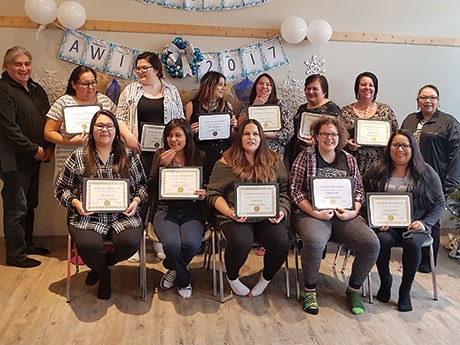Life skills and industry training prepare women for work
By Nadine Robinson
It’s 2013, a labour shortage looms and Indigenous women are underutilized and underrepresented in the mining sector. What do you do?
If you’re Ann Batisse, you create the Aboriginal Women in Mining (AWIM) Program through the Temiskaming Native Women’s Support Group (TNWSG). Since the program’s inception, 229 Indigenous women from across northeastern Ontario aged 18 to 55 went through the program, 169 gained full-time employment, and 15 returned to school.
Batisse, a member of the Matachewan First Nation, is no stranger to major development initiatives, and has more than four decades of experience establishing programs across the socio-economic spectrum for Indigenous communities. In 2008, Batisse designed the Matachewan Aboriginal Access to Mining Training Strategy (MAATS), which exceeded projected targets with 345 Indigenous people in the region securing permanent, full-time employment.
“It was incredibly successful,” said Batisse, “but, since the majority of participants were men, we needed to apply a gender lens to the training and employment model.”
After securing funding from Employment and Social Development Canada (ESDC) and negotiating matching dollars from industry and community partners, Batisse created the Aboriginal Women in Mining program.
Each applicant completes a comprehensive assessment process to help identify their personal and professional goals, as well as their strengths, areas requiring support, and resources they may need.
“Depending on their skill and readiness, participants may be placed directly into a job, or get the required upgrading or training they require,” said Batisse. “No one is left out… we acknowledge and value the capacity each Indigenous woman has to contribute to the fabric of our communities.”
The program typically includes 10-12 weeks of life skills training, followed by a 12-20 week work placement.
“Placements are varied… underground, above ground, and some in administration,” said Batisse. “They drive the big trucks, work in the warehouse, do security, environmental monitoring, and camp services. Some became self-employed, establishing cleaning businesses, property management, and health and fitness services.”
Fifteen to 20 women are accepted at a time into the life skills program. They are in residence seven days on and seven days off to simulate the rotational shifts they would encounter at the mine site.
“Participants also need to feel safe and focused on learning, so we offer a number of wrap-around supports,” said Batisse. “We provide child care, transportation, mentoring, empowerment, advocacy services, and 24/7 supports.
Participants are also paid a small tuition fee, which is topped up for the on-the-job-training by some of our industry partners, including Detour Gold.”
Participants also learn Physical First-Aid, Mental Health First Aid, WHMIS and Food Handling. Upgrading is offered onsite for students who need to complete their grade 12.
“Our program has been recognized for addressing the complex barriers that Indigenous women face pursuing careers in mining and other non-traditional trades,” Batisse said. “We’re pretty unique, offering a culturally-rooted, community-based, inclusive program, guided by elders and led by Indigenous women.”
The training team is comprised of three life skills coach facilitators mentored by Batisse. Industry specific training is provided by various partners, including NORCAT, Detour Gold, Kirkland Lake Gold, and DeBeers, among other mining companies, which provide on-the-job training and full-time employment for graduates.
Batisse says that industry partners benefit from access to an untapped group of local employees with strong knowledge of what is expected on the job. She says partners want to continue their involvement with AWIM by extending training and on-the-job placement opportunities. Batisse recalls one partner saying: “This wasn’t just about giving women jobs, it was about making a real difference in their lives and in the lives of their families… and it is great.”
Women are selected through community outreach. Industry partners attend to provide information about opportunities within the mining industry.
“The response from Indigenous women has been outstanding,” said Batisse. “Many participants were stay-at-home moms or they worked low-paying jobs in the service industry, and many relied on social assistance programs. They’re excited to learn, to be well-employed and off social assistance, or more confident, and equipped with relevant skills.”
As Indigenous women from other parts of the country have accessed the AWIM program, the Temiskaming Native Women’s Support Group is now in the process of exploring an expansion into Newfoundland and Labrador, Quebec, and the Northwest Territories.



